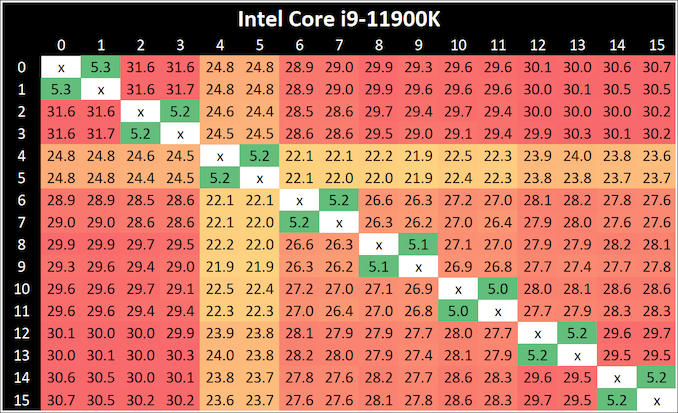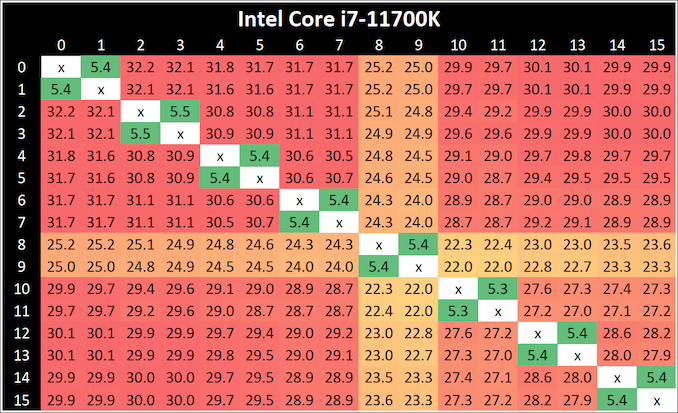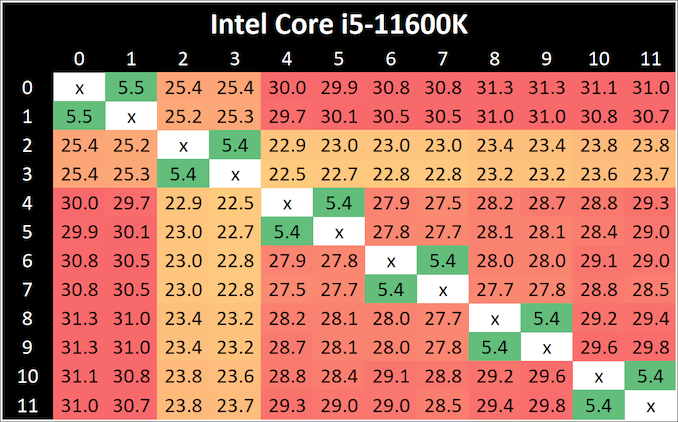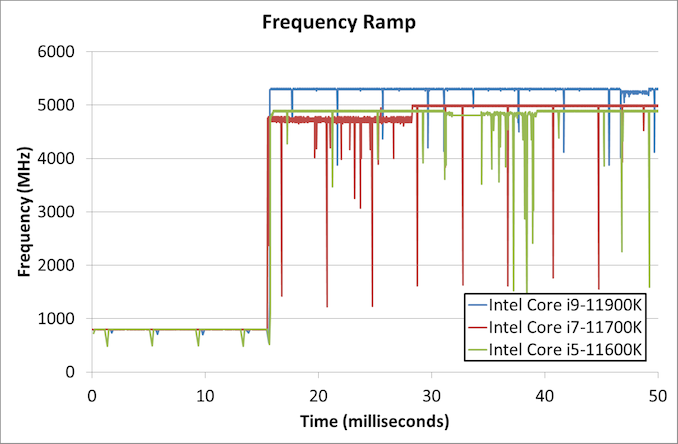Intel Rocket Lake (14nm) Review: Core i9-11900K, Core i7-11700K, and Core i5-11600K
by Dr. Ian Cutress on March 30, 2021 10:03 AM EST- Posted in
- CPUs
- Intel
- LGA1200
- 11th Gen
- Rocket Lake
- Z590
- B560
- Core i9-11900K
CPU Tests: Microbenchmarks
Core-to-Core Latency
As the core count of modern CPUs is growing, we are reaching a time when the time to access each core from a different core is no longer a constant. Even before the advent of heterogeneous SoC designs, processors built on large rings or meshes can have different latencies to access the nearest core compared to the furthest core. This rings true especially in multi-socket server environments.
But modern CPUs, even desktop and consumer CPUs, can have variable access latency to get to another core. For example, in the first generation Threadripper CPUs, we had four chips on the package, each with 8 threads, and each with a different core-to-core latency depending on if it was on-die or off-die. This gets more complex with products like Lakefield, which has two different communication buses depending on which core is talking to which.
If you are a regular reader of AnandTech’s CPU reviews, you will recognize our Core-to-Core latency test. It’s a great way to show exactly how groups of cores are laid out on the silicon. This is a custom in-house test built by Andrei, and we know there are competing tests out there, but we feel ours is the most accurate to how quick an access between two cores can happen.
All three CPUs exhibit the same behaviour - one core seems to be given high priority, while the rest are not.
Frequency Ramping
Both AMD and Intel over the past few years have introduced features to their processors that speed up the time from when a CPU moves from idle into a high powered state. The effect of this means that users can get peak performance quicker, but the biggest knock-on effect for this is with battery life in mobile devices, especially if a system can turbo up quick and turbo down quick, ensuring that it stays in the lowest and most efficient power state for as long as possible.
Intel’s technology is called SpeedShift, although SpeedShift was not enabled until Skylake.
One of the issues though with this technology is that sometimes the adjustments in frequency can be so fast, software cannot detect them. If the frequency is changing on the order of microseconds, but your software is only probing frequency in milliseconds (or seconds), then quick changes will be missed. Not only that, as an observer probing the frequency, you could be affecting the actual turbo performance. When the CPU is changing frequency, it essentially has to pause all compute while it aligns the frequency rate of the whole core.
We wrote an extensive review analysis piece on this, called ‘Reaching for Turbo: Aligning Perception with AMD’s Frequency Metrics’, due to an issue where users were not observing the peak turbo speeds for AMD’s processors.
We got around the issue by making the frequency probing the workload causing the turbo. The software is able to detect frequency adjustments on a microsecond scale, so we can see how well a system can get to those boost frequencies. Our Frequency Ramp tool has already been in use in a number of reviews.
From an idle frequency of 800 MHz, It takes ~16 ms for Intel to boost to the top frequency for both the i9 and the i5. The i7 was most of the way there, but took an addition 10 ms or so.














279 Comments
View All Comments
1_rick - Tuesday, March 30, 2021 - link
Half of those 16 cores are Atoms.shabby - Wednesday, March 31, 2021 - link
Atom on desktop... whoever thought of that should be fired.GeoffreyA - Wednesday, March 31, 2021 - link
In its original inception, Atom was utter rubbish but the microarchitecture has improved a lot since then (Bonell > Goldmont > Goldmont Plus > Tremont > Gracemont). I've got a funny feeling that this design, taken further, could become their main one in the future. Similar to the Pentium M becoming Core.mitox0815 - Tuesday, April 13, 2021 - link
The Pentium M had a major IPC advantage to begin with - it was a full-fat-core based off the P6, after all. The Atom derivates don't have that, they were compromised designs from the get-go.Spunjji - Friday, April 9, 2021 - link
When will AMD catch up with an unreleased product? Some time after it's released and it makes sense to catch up, presumably... 🤡mitox0815 - Tuesday, April 13, 2021 - link
8 of those are Atom cores...gahd dingit Intel, give us 16 full-sized cores on mainstream! Spare me the cop outs. Granted, finding a way for that to NOT draw 400W+ on its own first would be nice...Oxford Guy - Wednesday, March 31, 2021 - link
And consumers always pay the price for having quasi monopolization.We get overpriced quads from Intel for forever.
Then, we get overpriced 5000 series from AMD.
rinse, repeat
Having adequate competition is supposed to fix the problem of capitalism. Monopolization is not supposed to occur. But, when it does... it concentrates wealth rapidly in the hands of few. Everyone else gets to pay much more for far less. They have the 'choice' of that or nothing.
Qasar - Wednesday, March 31, 2021 - link
"Then, we get overpriced 5000 series from AMD." FYI, the prices are the 5000 series are partly do to the current situation, and demand. cant really blame AMD for stores setting the prices they charge.you seem to be one one angry person oxford guy....
Oxford Guy - Thursday, April 1, 2021 - link
Ok ELIZA. : )Spunjji - Friday, April 9, 2021 - link
Intel seem to think AMD's prices are fair 😬